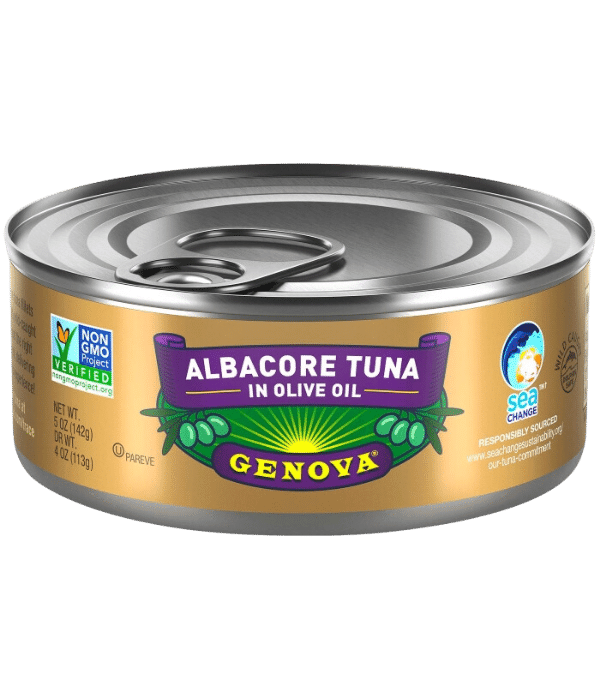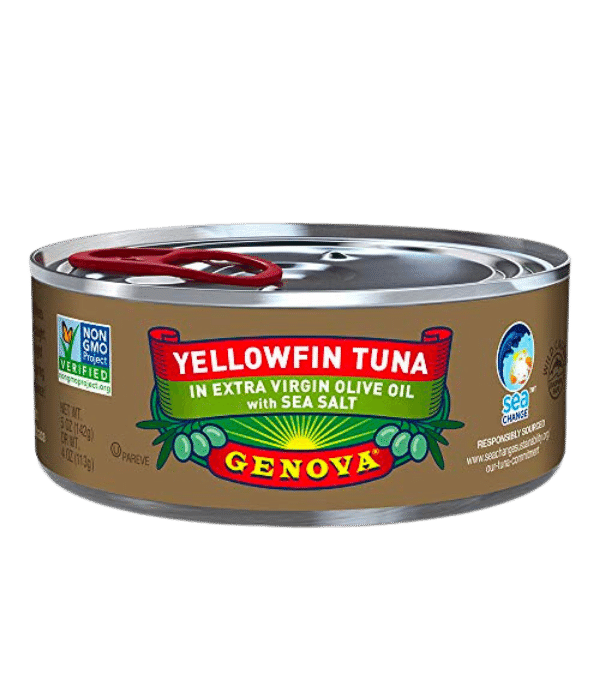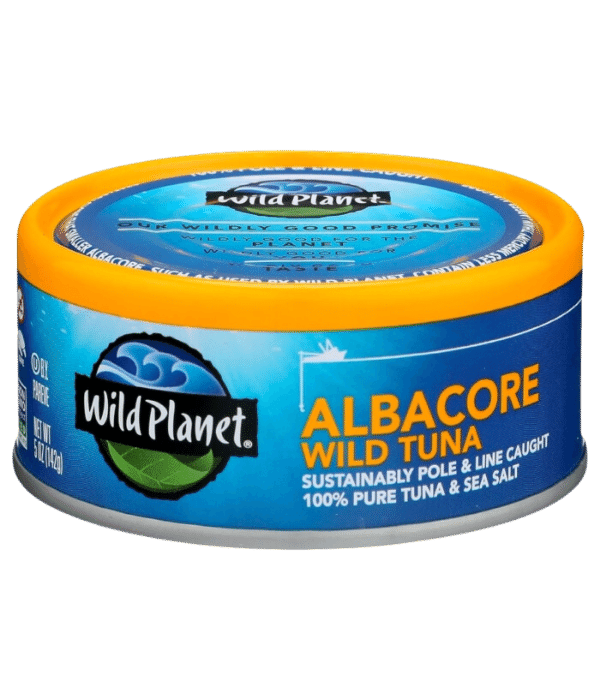Talk to a Registered Dietitian and use INSIDER20 for 20% off!
Talk to a real Dietitian for only $99: Schedule Now
This post contains links through which we may earn a small commission should you make a purchase from a brand. This in no way affects our ability to objectively critique the products and brands we review.
Evidence Based Research To fulfill our commitment to bringing our audience accurate and insightful content, our expert writers and medical reviewers rely on carefully curated research.
Read Our Editorial Policy
Water or oil? Yellowfin or albacore? Added salt or no? Canned tuna may seem like a cheap no-brainer of a pantry staple at first glance, but these factors and more can significantly affect taste, nutritional value, shelf life, and more.
Balancing key criteria like sodium content, calories, nutritional value, and price, we’ve arrived at a list of the 8 best canned tunas you can buy today.
To showcase the winner, we couldn’t pass up Genova Albacore Tuna in Olive Oil, our favorite wild-caught tuna that’s tasty, loaded with protein, and tied for cheapest on our list.
Best Overall | Best Value | Sustainably Caught | |
|---|---|---|---|
| Product | Genova | Genova | Wild Planet |
| Key Points | Wild caught; non-GMO verified; all-natural ingredients; 29g protein per serving and 280mg sodium | Wild caught; non-GMO verified; all-natural ingredients; 28g protein and 500mg sodium; extra-virgin olive oil and sea salt | Sustainably line and pole caught; 100 calories per can; packed with neither water nor oil; 21g protein and 200mg sodium |
| Price | $30.24 for 12 x 5 oz ($0.50/oz) Shop Now | $60.24 for 24 x 5 oz ($0.50/oz) Shop Now | $4.99 for 1 x 5 oz ($1.00/oz) Shop Now |
Best for: Seafood purists looking for a delicious, wild-caught, and oil-packed canned tuna at a highly competitive price point.
Mild yet flavorful, rich in texture, and surprisingly affordable, Genova clearly aimed for “crowd pleaser” status with their Albacore Tuna In Olive Oil, and we would say they nailed it.
Of course, as with all tuna packed in oil, you’re looking at a higher calorie count, but nutritious calories nonetheless.
Here’s a quick breakdown of the nutrition facts (per serving):
There are only three ingredients: solid white albacore tuna, olive oil, and salt.
While we would like extra-virgin olive oil, the consistently well-reviewed taste and texture of this albacore tuna product—which also comes in water, calabrian chili infused olive oil, and olive oil without salt—is not to be overlooked.
Also, this product is tied for the lowest price point on our list ($0.50/oz).
If you’re looking for some tasty tuna and you’ve budgeted for a few extra calories, Genova Premium Albacore Tuna In Olive Oil is the best canned tuna brand (and product) in our book.
Best for: Yellowfin tuna fans looking for a super clean, oil-packed tuna without any low-quality ingredients or additives.
If you aren’t clear on the main differences between yellowfin and albacore tuna, yellowfin generally has a stronger taste and a softer, richer texture than albacore, which is also called white tuna.
Yellowfin also tends to have higher amounts of mercury than white tuna, an important consideration for people who tend to eat tuna more often.
Genova models a superior product once again for those who prefer yellowfin, adding only extra-virgin olive oil and sea salt to their Yellowfin Tuna In Extra Virgin Olive Oil.
Again, the oil will bump up the calories as compared to tunas packed in water, but they’re highly nutritious calories.
Here’s a look at the nutrition facts (per serving):
As long as you budget for the calories (and sodium), price is all but a non-issue at a very competitive $0.50 per ounce with Genova Yellowfin Tuna, the best tuna fish for value hunters.
Best for: Those looking for the most eco-friendly premium albacore tuna; anyone who prefers a milder taste and/or fewer calories or sodium.
Though you’ll pay a bit more for it, Wild Planet Albacore Tuna offers several key advantages for shoppers looking to soften their environmental impact, cut down on calories and sodium, and more.
First, every tuna is pole and line caught, and they’re smaller, meaning the amount of mercury is lower.
It’s also important to note that this tuna is packed with neither water nor oil, keeping calories, fat, and sodium very low. Here’s a snapshot of nutrition facts (per serving):
Fans of oil-packed tuna may be miffed at the milder flavor in this case, but otherwise, Wild Planet Albacore Tuna is our pick for the best tuna fish in terms of environmental impact. .
Best for: People who prefer a sustainable yellowfin tuna product, but are also mindful of calories, sodium, etc.
Depending on your specific preferences, Tonnino Yellowfin Tuna in Spring Water may be a “best of both worlds” situation for you, as you can enjoy the rich taste of yellowfin with fewer calories, thanks to the use of spring water over oil.
Here’s how the major nutrition facts break down on a per-serving basis:
While there are 2 or 3 fewer grams of protein than most canned tunas we’ve reviewed—makes sense given the smaller container—the paltry 85 calories and 0.5 grams of fat are very appealing for anyone looking to slim down.
We also appreciate how Tonnino Yellowfin Tuna in Spring Water is sourced from the Inter-American Tropical Tuna Commission (IATTC), ensuring that each wild-caught tuna has the lowest environmental impact possible.
Best for: People looking for a low-sodium and lower-calorie tuna option that still tastes great without harming the environment.
Especially if you’re already a fan of milder albacore tuna, Blue Harbor Wild Albacore In Water offers an affordable, sodium-reduced option that’s certified sustainable.
Each serving of Blue Harbor contains 150 calories, 100 milligrams of sodium, 2 grams of total fat, and a generous 32 grams of protein.
Considering these macros, we would recommend this tuna for bodybuilders and other athletes looking for a leaner source of protein they can have regularly, though you still need to keep in mind that the mercury content is unavoidable.
Finally, Blue Harbor Albacore Tuna in Water is certified sustainable by the MSC (Marine Stewardship Council), so you can munch (chew?) with peace of mind.
Best for: People who consume tuna more regularly and are looking to limit mercury intake; anyone who wants a sustainable, low-sodium tuna with premium taste.
Thanks to considerably reduced sodium, mercury, and calories, Safe Catch makes a very strong argument both for the nutritionally aware and anyone looking to replace less eco-friendly products with affordable and sustainable ones.
Each serving contains 100 calories, just 25 milligrams of sodium (no salt added), 1.5 grams of fat, and 22 grams of protein, making this one of the healthiest canned tuna products aside.
Also, all Safe Catch tunas are tested for mercury content, and if they exceed a low limit, are not accepted. Though it’s a close race on taste and texture, we can unequivocally say Safe Catch is the best canned tuna brand for people closely watching their mercury intake.
All the tunas are pole and line caught, and Safe Catch is plastic-neutral, dolphin-safe, and turtle-safe.
Best for: Tuna purists who want the tastiest tuna out there that can be eaten straight from the can or paired with dozens of dishes.
Prized by the Spanish as a rich delicacy and exported across the world, Bonito Del Norte is a delicious white (longfin) tuna, and Ortiz is largely agreed upon to be the name to go to if the hankering for bonito strikes.
While Ortiz offers a canned-in-water option, if you’re going to go with Bonito del Norte, you simply have to do olive oil for the added richness.
Though you may have a few extra calories to contend with, you don’t have to sacrifice your commitment to sustainability in order to enjoy some Bonito del Norte, as all Ortiz tuna (longfin, by the way) is caught by the rod.
Whether or not you want to keep the Spanish cuisine theme or go cross-continental, there are hundreds of Bonito del Norte recipes out there (tuna melt and tuna salad are just the beginning) to punch up the flavor even more.
Best for: Tuna fans looking for a spicy and switched-up variety to eat alone or in conjunction with more picante dishes.
If you know, you know—jalapeno is a criminally underrated accent to make any dish pop (and then some), so we appreciate where Tonnino is going with this Smoked Jalapeno Yellowfin Tuna.
The richness of the tuna, the smoked olive oil, and the jalapeno mingle together into a smooth, yet spicy food that can be snacked on right out of the jar with little complaint of blandness.
Granted, you’re getting a little over double the sodium (300mg, 2 servings per jar) of most non-flavored tuna products, and smoked olive oil may introduce some potentially toxic compounds, so this is not the healthiest canned tuna. We would categorize this as an occasional indulgence rather than a staple.
Like other Tonnino products, the fish that goes into their Smoked Jalapeno Yellowfin Tuna are line and pole caught, reducing the impact on the environment.
The answer often boils down to preference.
Pouch tuna is usually not packed with liquid, so it can be drier, often requiring added oil, sauce, etc. Canned or in a pouch, tuna contains higher amounts of mercury than most fish and is often restricted in the diets of pregnant or breastfeeding women as well as young children.
If you go with one of the best canned tuna brands like Tonnino or Genova, the can or the pouch both offer a nutritious, tasty option.
Albacore tuna is widely considered to be a highly nutritious food, thanks to its high protein content, minimal fat, and broad range of vitamins and minerals. This makes it an excellent substitute for processed lunch meat and other less nutritious sources of protein.
There are too many premium tinned fish products out there to definitively name one as the healthiest tuna, but there are several factors you can consider when shopping for canned tuna that can steer you towards healthier options.
These include whether or not there is added salt (sodium >400mg?), the amount of protein, the type of tuna (albacore has less mercury than yellowfin), how and where the tuna is caught, and whether or not there are any additives or flavorings. The healthiest tuna will have 20+ grams of protein, less than 400 milligrams of sodium, and no sketchy additives thrown in.
All tuna contains mercury, but the kind of tuna (and size) can affect concentration, with yellowfin usually surpassing albacore (white) tuna.
Fortunately, brands like Safe Catch test for mercury, not accepting any tuna that surpasses a low limit. This makes Safe Catch tuna the safest tuna to eat if you’re concerned about mercury content.
Answers can vary significantly depending on the type of tuna and each person’s individual circumstances, but most health and nutrition authorities (like the FDA and EPA) set a limit of up to 2-3 servings of low-mercury tuna (like albacore, skipjack tuna, etc.) per week.